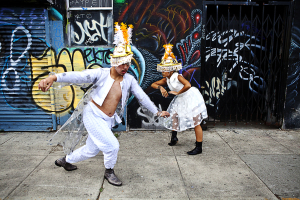
A BEAUTIFUL YOUNG WOMAN is shaken awake by her troubled dreams. She rushes to work, but the dream haunts her: a chill on her spine, a cold feeling on her neck. Dogged
by ghostly figures, she trembles, clutching her hair in distress. Seemingly a world away, a young woman lights a candle, calls forth a blessing, and lays an offering to the spirits of
her ancestors. Are these spirits here to haunt her, or protect her?
Alleluia Panis examines the line between the spirit and modern world in her new multimedia dance work She, Who Can See. After a sold-out run in May (presented by API Cultural Center as part of the Ma’ARTes Festival and the 18th Annual United States of Asian American Festival), the show returns to Bindlestiff Studio in San Francisco for an extended run this September. In it, Salima — brought to life with dynamic physicality and emotional ferocity by dance artist Alexandria Diaz De Fato — is an American woman of Filipino descent caught in the cultural crossroads, haunted by an inherited legacy of shamanism. White-clad spirits (performed by June Arellano, Rebecca Fazio, Jonathan Mercado, and Sammay Dizon) appear before Salima on the streets of San Francisco. Confused and scared, Salima struggles with these erratic visions, and we, as the audience, are drawn into the delirium of her struggle. As a ballast, we encounter the grounding influence of Nico, her partner (performed by martial artist/dancer Gregory Manalo), valiantly supporting Salima on her journey.
Performed to tribal-inspired music by Florante Aguilar, dancers nimbly leap between spaces — now on-stage, now on-screen — flashing a clever smile from the steps of an
old Victorian or winking from the BART platform. Panis, both choreographer and director, deftly blends live dance with film from Wilfred Galila, bringing the audience deeper into Salima’s frazzled mind.
The tension of culture and magic
Salima’s crisis is not only personal, but is symptomatic of a larger cultural condition. Though she lives a middle-class American lifestyle, she has inherited a sacred gift (or curse?) of shamanism. Salima must balance the insistent demands of her indigenous “pre-colonial self,” within the reality of her western world, wherein such spiritual ‘gift’ is considered nonsense, delusional, or taboo. Inspired by several real-world women, Salima becomes a foil to explore the question “How do people who see both the physical and the non-physical keep their sanity?”
She, Who Can See is a natural progression for Panis, an experienced choreographer and director. In her thirty-plus-year career, Panis has created more than fifteen fulllength dance-theater works, many of which investigate the “constant cultural negotiation” of balancing indigenous heritage within the contemporary world. Panis describes her work as drawing upon “the fluid articulation of Pilipino traditional dance, mystical elements of indigenous ritual dances, the muscularity of the escrima blade-fighting system, and the vertical physicality of modern dance.”
Panis returns biennially to the Philippines to recharge by participating in the ritual of ipat, an elaborate pre-colonial healing ceremony wherein a spiritual healer (baylan or shaman) becomes a vessel for ancestral spirits to communicate with the living. Lasting 4 to 14 days, ipat brings the entire community together in the both physical and spiritual healing process. On one of these visits, Panis experienced her “ah-ha” moment. She realized that ritual itself is a complete theater experience that deeply draws in participants and spectators alike. Panis explains, “The chanting, the music, the dance, and the intricately-designed offerings, all of it — this is what theater is supposed to be: a transformative experience that changes both artist and audience.”

Creating through collaboration
Panis engaged talented collaborators to help bring Salima’s story to life. Florante Aguilar, a classically-trained musician and composer created the music score. Although he has previously worked with Panis, the indigenous rhythms and instrumentation used in She, Who Can See represent a stylistic departure. Aguilar, the subject of the film documentary Harana (Serenade), explains, “It’s the opposite end of the spectrum, from the familiar western mode to indigenous scales and instrumentations. It was a fun challenge.” The challenge pays off, setting a vivid backdrop. Aguilar says the collaboration worked because of Panis’s “clarity of vision, combined with creative freedom.”
If Panis brought the vision and Aguilar provided the music, then Wilfred Galila is the filmmaker who joined both music and dance on-camera — which Panis then wove into the full-length production. Galila is a filmmaker and writer who has collaborated with Panis in several endeavors, including Kodakan, a photography and video exhibition that explores the many layers of Filipino-American identity. She, Who Can See peers into the layers of identity and spirituality with a truly artistic eye.
The film winds in and out, as dancers melt from screen to stage. Panis uses the juxtaposition to bring us intimately into Salima’s experience. She explains, “In live theater, we see the full body within the theatrical space; but in film, we are able to get close, and see the emotional details of the character.” Indeed, the desire for this immediacy was a major factor in choosing Bindlestiff Studio in San Francisco as her venue. Panis says, “I want to immerse the audience in Salima’s desperate sense of entrapment, of intrusion, of worlds in collision. To make the audience emotionally and physically feel the chaos of Salima’s internal landscape, the work is purposely layered. We hoped for the audience to bridge the divide between the digital and the live.” She adds, “As Salima’s journey is confined within her body, the audience is also confined within the walls of this little black box theater.”
Back for More
She, Who Can See brings together the creative spark of Panis’ vision. Also in the works: a film production, to carry this piece into perpetuity. Says Wilfred Galila, “The task is to bring back a dream that was manifested on stage to the dreamlike medium of cinema, to bring what was imagined back into the realm of the imagination.”
Awake, Salima lights a candle, her face calm. But does Salima find healing? Alleluia muses, “The truth is, rituals define the ‘sight,’ give it boundaries, but they don’t make it go away. How we move forward, how we accept traditions and choose to practice them, remains open.” Decide for yourself when She, Who Can See returns to Bindlestiff Studio in September.


